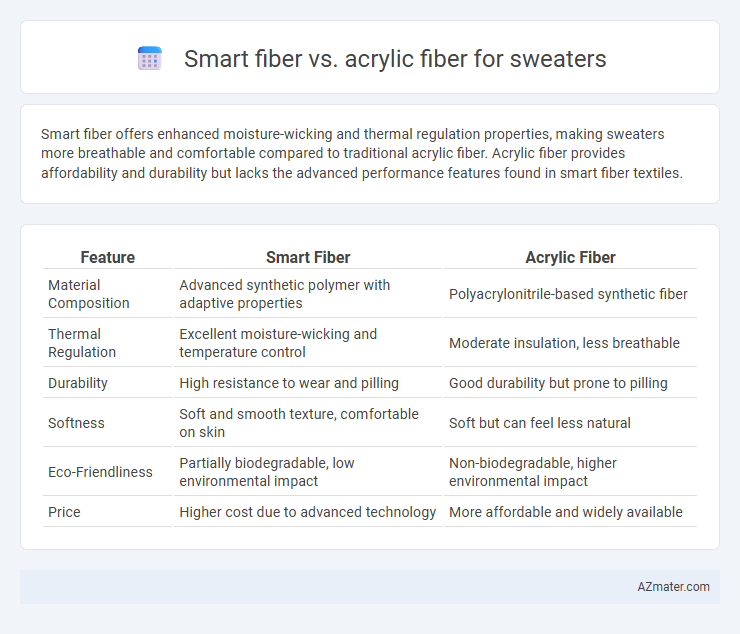Smart fiber offers enhanced moisture-wicking and thermal regulation properties, making sweaters more breathable and comfortable compared to traditional acrylic fiber. Acrylic fiber provides affordability and durability but lacks the advanced performance features found in smart fiber textiles.
Table of Comparison
| Feature | Smart Fiber | Acrylic Fiber |
|---|---|---|
| Material Composition | Advanced synthetic polymer with adaptive properties | Polyacrylonitrile-based synthetic fiber |
| Thermal Regulation | Excellent moisture-wicking and temperature control | Moderate insulation, less breathable |
| Durability | High resistance to wear and pilling | Good durability but prone to pilling |
| Softness | Soft and smooth texture, comfortable on skin | Soft but can feel less natural |
| Eco-Friendliness | Partially biodegradable, low environmental impact | Non-biodegradable, higher environmental impact |
| Price | Higher cost due to advanced technology | More affordable and widely available |
Introduction to Sweater Fiber Options
Smart fibers for sweaters integrate advanced materials like phase-change or moisture-wicking properties, enhancing comfort, temperature regulation, and durability. Acrylic fibers offer a synthetic alternative, known for their affordability, lightweight feel, and resistance to moths and mildew. Choosing between smart fibers and acrylic depends on desired performance characteristics, budget, and maintenance preferences for sweater wear.
What is Smart Fiber?
Smart fiber is an advanced textile technology engineered for enhanced durability, moisture-wicking, and temperature regulation, making it ideal for sweaters that require comfort and performance. Unlike traditional acrylic fibers, smart fibers often incorporate bio-based or synthetic components designed to adapt to environmental changes, providing superior breathability and resilience. These features result in sweaters that maintain shape, resist odor, and offer better thermal insulation compared to conventional acrylic fiber garments.
Understanding Acrylic Fiber
Acrylic fiber, a synthetic polymer made from polyacrylonitrile, offers lightweight warmth and excellent resistance to moths, oils, and chemicals, making it a durable choice for sweaters. Unlike smart fibers that incorporate technologies for moisture-wicking or temperature regulation, acrylic fiber provides consistent insulation and color retention even after multiple washes. Its affordability and easy maintenance appeal to consumers seeking cost-effective sweater materials with a soft, wool-like texture.
Key Properties: Smart vs Acrylic Fiber
Smart fibers exhibit superior moisture-wicking and thermal regulation compared to acrylic fibers, enhancing comfort in sweaters across varying temperatures. Acrylic fibers are known for their lightweight, soft texture, and resistance to moths and chemicals, making them durable and easy to maintain. While smart fibers offer enhanced breathability and adaptability to environmental changes, acrylic fibers provide consistent insulation and vibrant color retention.
Comfort and Wearability Comparison
Smart fiber sweaters offer superior moisture-wicking properties and temperature regulation, enhancing overall comfort during prolonged wear. Acrylic fiber sweaters provide warmth and softness but may lack breathability, leading to potential overheating and reduced wearability. The advanced technology in smart fibers ensures a lightweight, stretchable fit that maintains shape and comfort better than traditional acrylic materials.
Durability and Longevity
Smart fiber sweaters offer superior durability due to advanced synthetic blends designed to resist pilling, stretching, and fading, maintaining their shape and color over time. Acrylic fibers, while lightweight and affordable, tend to degrade faster with frequent washing and prolonged wear, often leading to reduced fabric strength and visible wear. Choosing smart fiber ensures enhanced longevity and sustained garment quality, making it a preferred option for durable sweaters.
Warmth and Insulation Performance
Smart fiber sweaters offer superior warmth and insulation performance due to advanced moisture-wicking and thermal-regulating properties that retain body heat efficiently. Acrylic fibers provide good warmth but lack the breathability and adaptive insulation of smart fibers, often resulting in less comfort during temperature fluctuations. For optimal warmth and consistent insulation, smart fiber sweaters outperform traditional acrylic fiber alternatives.
Care and Maintenance Differences
Smart fiber sweaters offer enhanced durability and stain resistance, requiring less frequent washing and easier spot cleaning compared to acrylic fibers. Acrylic sweaters tend to attract static and pill more easily, necessitating gentle hand washing or delicate machine cycles and air drying to maintain fabric integrity. Smart fiber materials often incorporate moisture-wicking and odor-resistant technologies, reducing the need for intensive maintenance routines typical for traditional acrylic sweaters.
Environmental Impact and Sustainability
Smart fiber sweaters typically feature biodegradable materials derived from renewable resources, reducing landfill waste and lowering carbon footprints compared to conventional acrylic fibers. Acrylic fiber production relies heavily on petrochemicals, resulting in significant greenhouse gas emissions and non-biodegradable microplastic pollution. Sustainable choices favor smart fibers for eco-friendly fashion, emphasizing reduced environmental impact through renewable sourcing and enhanced biodegradability.
Choosing the Best Fiber for Your Sweater
Smart fiber offers superior moisture-wicking, durability, and temperature regulation, making it ideal for sweaters designed for active wear or varied climates. Acrylic fiber provides affordability, lightweight warmth, and ease of care, suited for casual and budget-friendly sweaters. When choosing the best fiber for your sweater, prioritize smart fiber for performance and longevity, while acrylic suits comfort and cost-efficiency.

Infographic: Smart fiber vs Acrylic fiber for Sweater
 azmater.com
azmater.com